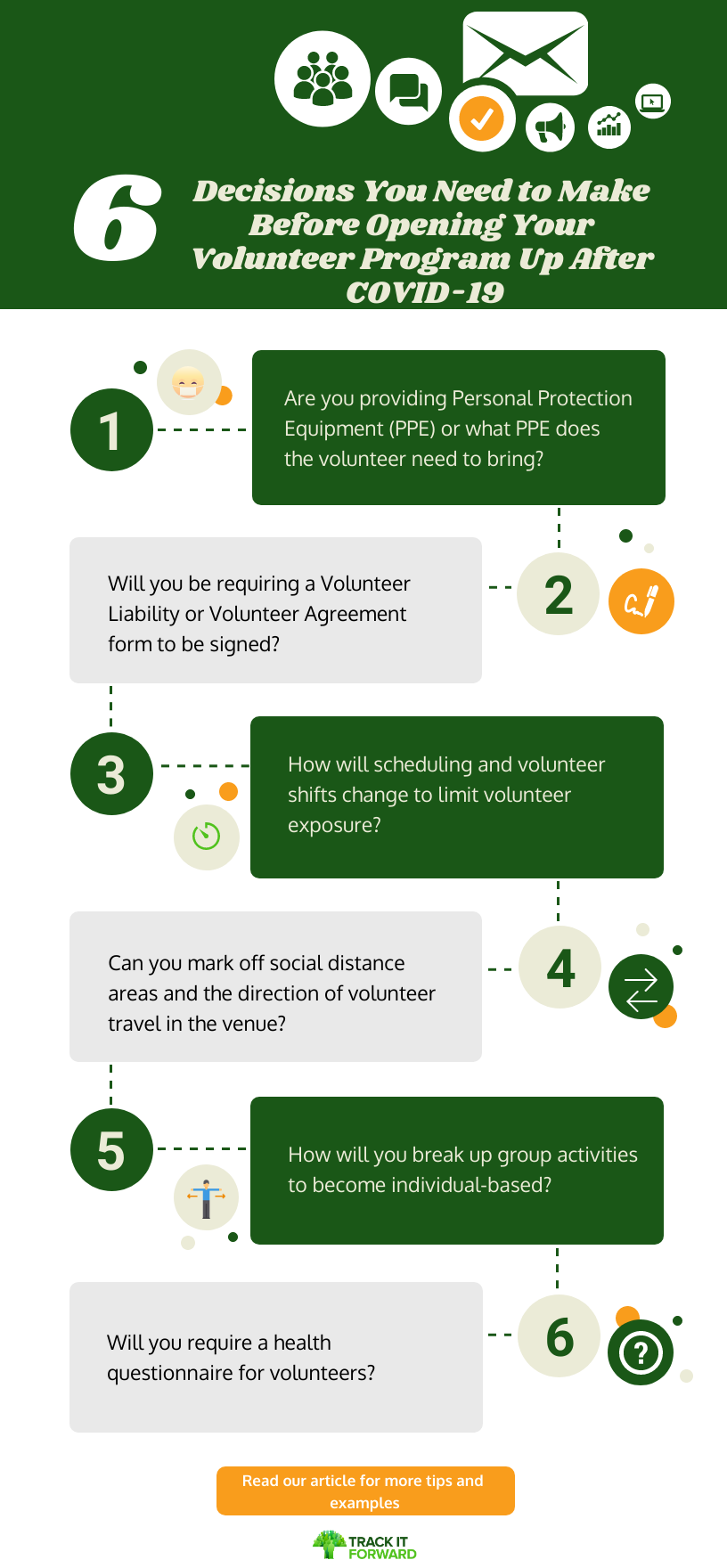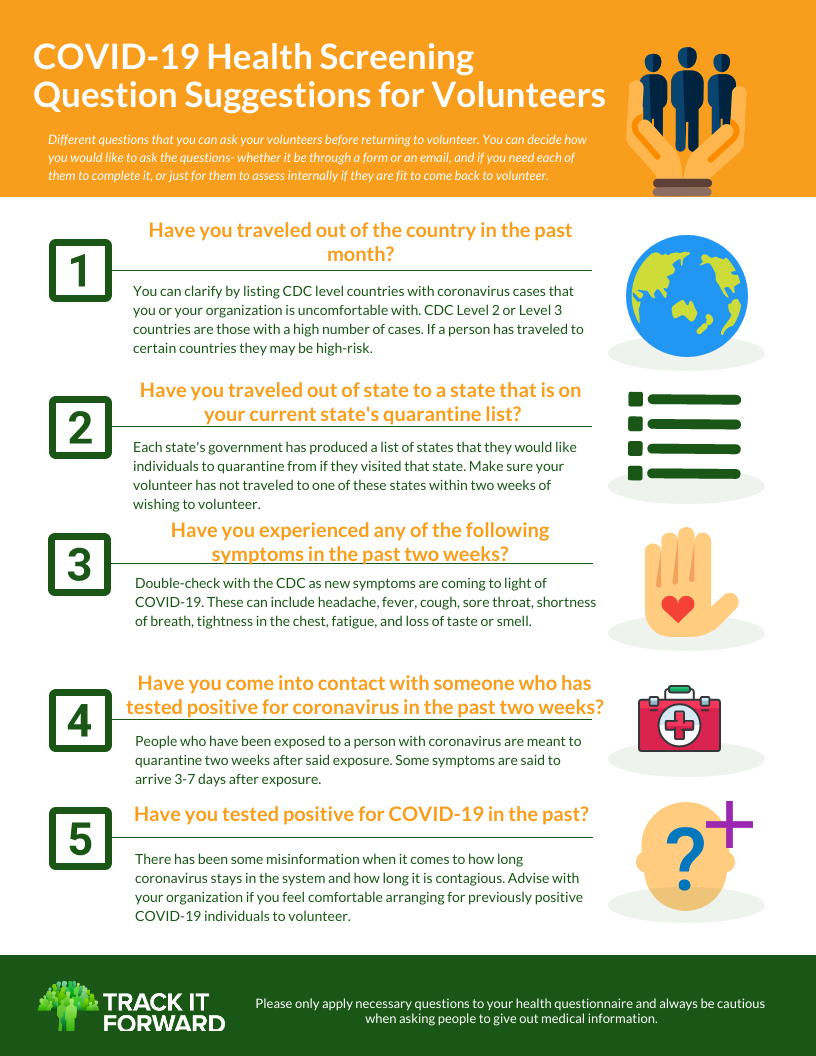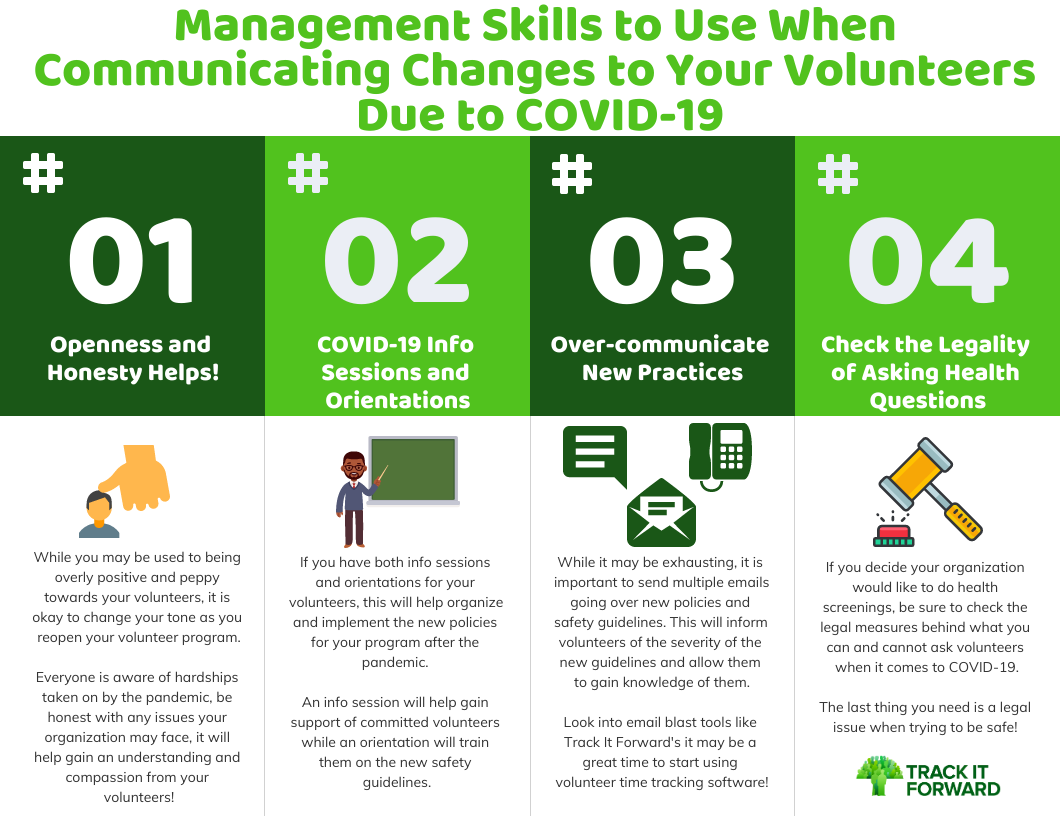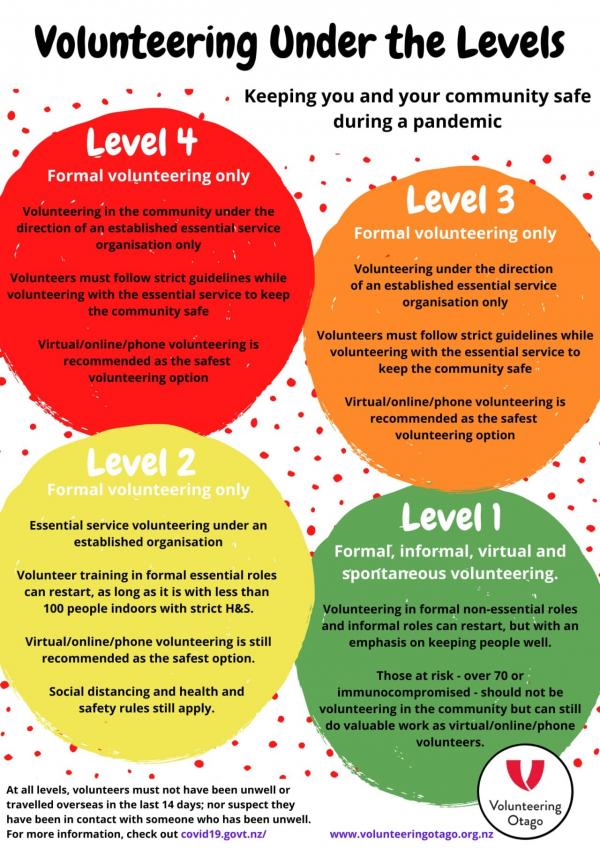As many states decide to reopen some volunteer programs after COVID-19 shutdowns, some volunteers really want to get back to volunteering, and some nonprofit organizations need volunteers now more than ever. COVID-19 has left many volunteer programs to be redesigned and the precise act of volunteering will take on a completely new normal. We have created this guideon how to tackle reopening and reorganizing your volunteer program with new rules and guidelines that coronavirus has set.
As things, events, and organizations are reopening after the shelter in place and quarantine orders due to COVID, it is important for all volunteer coordinators and managers to consider if/when their program will reopen, how they will protect their volunteers against exposure to the virus, and how they will protect anyone that comes into the organization from possible exposure.
While medical situations and facts may not be all of our strong suits, it is imperative that we become educated on the up to date studies done by the CDC and the guidelines for each state so volunteering during COVID measures is safe and not putting anyone in danger.
Some of the following tips on how to handle your volunteer program during coronavirus were ideas from members of the Volunteer Coordinator Resource Community, join the community for more specific ideas for different organizations.
The Guide for Your Volunteer Program During COVID is broken up into three sections: before bringing back volunteers, management communication, and tips to follow as volunteer programs start back up. It is never too late to implement any of these ideas into your volunteer program as it reopens after the pandemic.
Volunteering During COVID-19: Before Bringing Back Volunteers
There are a good amount of decisions and ideas that should be considered before you completely open your doors to the community, and especially to volunteers. Figure out how risky your volunteer program might be when it comes to coronavirus and the public. You should also assess how certain volunteer tasks can be amended to be the safest practice. You should also start to consider new volunteer tasks that may need to be made due to COVID-19 guidelines.
These fundamentals of your volunteer program will have to be assessed through all stages of your volunteer program reopening during COVID-19. Be sure to know exactly what is necessary for your program, the activities that should be prioritized, and how you will change and adapt throughout the future. It is okay if this takes multiple days or weeks! You need to have a solid understanding of the new guidelines and the new normal for your organization and your volunteers as you reopen volunteer opportunities in coronavirus times.

1. Decide if you are providing PPE to Volunteers During COVID-19
Personal Protective Equipment (PPE) is going to be a necessity, no matter what your volunteer program while coronavirus is still present. This includes, at minimum, a mask and hand sanitizer. Other initiatives have included gloves, face shields, name tags, and important information in paper handouts.
If you are going to be providing any sort of PPE, make sure you have the equipment in sealed plastic bags to avoid excessive touching from multiple people. Think about what a volunteer may need throughout their shift. If there are certain restrooms they have to use or new rules they need to follow - put this along with any other new rules in a bag with their PPE!
If you are unable to provide your volunteers with PPE- that is okay! PPE can be expensive and if you do not have a source that can give them to you in bulk, or donate them, it is okay to require your volunteers to bring their own. At this point in the pandemic, it is pretty standard for people to own their own personal masks and carry around sanitizer! We suggest that you keep a couple of maks and gloves extra just in case a volunteer forgets to bring their own.
Once you decide if you are able to do this, be sure to make a note to include this decision in an email to your volunteers - let them know if they need to bring their own, and what they should bring. By keeping your volunteers updated about things like PPE, they will know you are taking COVID-19 seriously and will be safe volunteering.
2. Create liability waivers and volunteer agreement forms specific to COVID-19
Waivers and Agreement forms are a great way to help layout your organization’s new guidelines and to explain the possible exposure a volunteer may face. Waivers are more so for legal reasons. This may work better for organizations that are tied to the government or work often in an area that may be worried about possible exposure. Agreement Forms are a more casual version of a waiver, that a volunteer can back out of, basically showcasing their options.
It is good for a volunteer program to at least have one of these forms signed by volunteers as volunteer programs reopen during coronavirus. Liability Waivers and Volunteer Agreement Forms help showcase to volunteers how seriously your organization is taking the pandemic and their safety. It is also a way to communicate the new guidelines and precautions that are taking place when volunteer programs open with COVID-19 still present.
3. Update volunteer shifts and schedules to lessen COVID exposure between volunteers
As your volunteer program opens in this new normal, it is a good idea to consider minimizing the number of people coming in to volunteer. For staff that may be there every day, it is important to not expose your self to a large number of people at once. This could mean rearranging the schedule to have longer shifts and fewer volunteers at once. Some organizations like animal shelters and Habitat for Humanity have implemented this option, allowing people to volunteer in “groups” while social distancing - this way they are only exposing themselves to the same people each time they volunteer.
It is up to you how you implement a new schedule, but it is okay to be strict with this! It is your responsibility as a volunteer coordinator to consider the repercussions of your volunteer schedule. Be sure to communicate the reasoning for new schedules and shifts to each of your volunteers!
In coming up with volunteer scheduling, it is great to have an event calendar like Track It Forward’s. This event calendar can help you schedule out volunteer shifts, have volunteers sign up for them directly within the calendar, and track volunteer hours instantly.
4. Create social distance markers or areas
Imagine your volunteer site, is there a way for you to create different areas for volunteers to stay in the entire time they volunteer? This can help you group off volunteers so they do not expose themselves to other volunteers. Creating COVID-cautious social distance areas and groups for volunteers can help when your program reopens. If you plan this ahead of time, it will leave you with less to do when the volunteer programs get going.
If you do not have the option to do social distance area grouping, you should still consider social distance markers. If you are going to have volunteers doing a task in a specific spot, mark the closest another volunteer can come to that area without being closer than 6 feet. This can be done with tape on the ground or signs. This can also be done with seating, lines that may be made, and walking directions when going around the area.
For example: create a walking path for a volunteer to walk in one direction so they will not run into a volunteer going the other direction.
While this may be hard to think of, if you come up with a map, it will be a great visual way for volunteers to understand if they are sent it ahead of time or in their PPE bags. It will also be easy for you or another staff member to follow the map when placing the signs or markings in the venue.
5. Recreate Old activities to minimize group work
Think about the tasks that your volunteers usually complete. Do they need to be done in a group? If not, you can separate these group tasks to comply better with COVID-19 guidelines.
Although many of your volunteers may like to volunteer for a social aspect, it is important to consider their health and other people who may be completing the tasks. Recreate the program to allow people to work on their own easier. Volunteers can still be near each other (outside of 6 feet) if they would like to be social. Or, volunteers who come together can complete group tasks.
This may also include breaking down tasks into smaller parts. This can allow individuals to complete the tasks separately, and when they come together it is the same as if they were in a group.
Think about the different tasks and initiatives that volunteers usually complete and how they can be changed or broken down. It will help create a safer working environment and volunteer program as your organization reopens.
Another activity you should think about is the check-in process for your volunteers. If you use a check-in process that usually required signing in on a sheet of paper or even on a shared device - this may not be the case anymore. People do not want to touch multiple things that other people touch. There are a few options to help this issue:
- Have a mobile hour logging session
- If you don't want your volunteers to log hours, use an event calendar and then verify the event and volunteers there to gain the event attendance sheet.
- Use the Check-in Kiosk. Have one person (who is heavily protected with PPE) operate the kiosk and sign people in and out for their shift, then the hours log automatically and no one is exposed!
6. Concur if COVID Health Screening Questionnaires will be used on volunteers
Some organizations are conducting health screenings for their volunteers. This can be used to assess if a volunteer is capable and safe to volunteer and be around others. The questionnaire can have a multitude of questions that are yes or no. If a volunteer answers “yes” to a certain amount of questions, you can ask them not to volunteer at this time.
Of course, you should be sincere and explain why you are asking the questions and turning volunteers down at this time. You should also implement the volunteer with an agreement form that says they are speaking the truth in the questionnaire.
You should work with CDC resources when creating the questionnaire to figure out what may be dangerous to your program depending on the state you live in and the symptoms of coronavirus.
You can do a health questionnaire when a volunteer signs up and “approve” them shortly after, or give the health questionnaire out via email and let people know if they do not follow the questionnaire guidelines, they should not sign up to volunteer at this time.
Check out examples of health questionnaire below:

Management/ Communication Tips
The way that you communicate with your volunteers throughout coronavirus and in terms of reopening your doors for them to volunteer may be a bit different than how you did prior. A lot of volunteers are going to be questioning some of the new changes, it is important that you stand your ground when it comes to the decisions you and your organization has made.
We have found that many volunteer coordinators feel being open and honest about challenges and tough times works best when dealing with explaining changes to long-term volunteers. Be sure to explain why each change is happening, and always reassure your volunteers that these changes are only being made as a precautionary measure.

1. Be very open and honest about your program and concerns with Coronavirus and Volunteering
This could be if you are experiencing budget cuts, program cuts, or even just needing to cut down to a certain amount of volunteers. If this is the case, you may experience some upset volunteers, but that is okay. You just need to explain to them what is happening.
Everyone is aware of the financial hardships and reorganizing of existing programs due to COVID-19. If you are finding you have to deliver tough news to volunteers, it is okay to not be positive about it or even know the answers to some questions they have. Be honest with yourself and your volunteers when dealing with reopening your volunteer program. It will help eliminate the stress of trying to keep up a facade for your volunteers due to stress that COVID is causing.
Some volunteers might actually have advice on how to help or recreate the volunteer program during COVID, which is great!
2. Have Info Sessions and COVID-19 Volunteer Orientation
Volunteer Info Sessions and Volunteer Orientations are usually used to help recruit volunteers and train new volunteers. But, these information sessions and orientations can be used specifically to go over new programs and COVID-19 guidelines within the volunteer program. This will be a great way to gain volunteers who are serious about volunteering and following new safety guidelines.
We suggest sending out an email where you talk about how things have changed and your organization is taking COVID-19 and CDC guidelines very seriously. Then link them to an info session that you can record and send to those interested, or you can do a live video chat.
Volunteer Info Session about Opening During COVID: this should contain information about how previous volunteer programs are changing, and go over all of the new programs/ tasks that a volunteer can do. You can also mention if your organization is going to work in brining volunteers back in phases, or if there are only a limited number of volunteer spots available. If volunteers are still interested after this info session, ask them to attend a volunteer orientation.
Volunteer Orientation about Operating Under Coronavirus Guidelines: here is where you can talk about scheduling, shifts, and specific guidelines for each volunteer event. We recommend doing this virtually, just since it may be a larger amount of people. You should go over all the programs and events a volunteer can sign up for in-depth, as well as the safety guidelines that must be followed. At the end, if you choose to do a health screening on your volunteers- explain this to them and send it out, you decide how you want to evaluate the health screenings. Then, inform volunteers of how they can sign up for events. It may be time to invest in a volunteer time tracking software that makes this easy!
3. Regularly send emails and overcommunicate to committed volunteers.
After a volunteer signs up for new events or volunteer opportunities in the pandemic, it is extremely important that you overcommunicate and reiterate the policies to them. This will not only express how serious your organization is, but it will remind them to be cautious when they are volunteering.
Some important things to send via email to them may be:
To bring their own mask/sanitizer
How long their shifts are
If there is a new process for signing in
What to expect if the task is a new one
Step-by-step instructions on how to complete their task or event they signed up for that they can print out.
You may want to consider using a software tool that has an email blast feature, like Track It Forward. This can allow you to easily send out emails to certain volunteers or people who signed up to volunteer in the reopening of your program.
4. Be careful asking about health to volunteers
Depending on your organization and state, it may be illegal to require volunteers to fill out a health screening. If the health screening form is not mandatory, there is a difference. Be sure you let people know that they do not have to fill out the health screening information if they are not comfortable with disclosing that information.
Be prepared and discuss with your organization how you wish to handle volunteers who do not participate in answering questions about their health or their possible exposure. Check out this website for more questions on legality.
While everyone is nervous about COVID, it is important that your volunteers still feel respected within your volunteer program operating during COVID-19.
As Volunteer Programs Start
When your program fully reopens after COVID-19 closures or with new Coronavirus guidelines, there will still be some upkeep that has to take place so your volunteers and organization can run smoothly under new operating conditions. These skills may be physical adjustments that you may have to make or just new internal things to work on within your organization.
1. Continue to send emails updating volunteers on programs occurring during COVID-19
Volunteers may feel different depending on the week or month. Some may be ready to volunteer if you will allow it. Remember to continually update your volunteers with the guidelines and events that the organization is allowing. You can do this with an event calendar or an email blast tool like the ones linked above.
Be sure to continually check CDC guidelines when it comes to new discoveries of COVID-19.
2. Come up with a COVID phase system where you will allow more volunteers
Some volunteer programs from our Volunteer Coordinator Resource Community Facebook Group have noted that they using a staggering or phasing system to help bring back volunteers in different phases. This would be a great strategy to use as we continue to move forward in this “new normal” world. Below is a photo of a system that a New Zealand program is doing. A system like this would be a great way to categorize volunteers, and to let them know what is happening in the program!

3. Continue to offer virtual or at-home volunteering
Virtual Volunteering is a great way to include volunteers who do not or cannot come out in the public due to the pandemic. Try offering virtual or at-home volunteering if your program can afford it. You would be surprised at how many things you can delegate to volunteers to do at home once you think creatively!
We suggest continuing to add and update virtual and at-home volunteering options, maybe for the next year or so!
4. Have “Health Monitors” who make sure volunteers are following guidelines
This is a great option for people who may have a good amount of volunteers spread out in different areas. Gather trusted volunteers or staff members from your organization and ask them to be health monitors. These people will be ensuring and monitoring that all volunteers are following new guidelines.
Your organization can decide how they will enforce the rules and regulations, but it is important that the safety guidelines are monitored!
Do you have any more tips or tricks that your organization is doing? Feel free to click the button below to fill out a form. We will review all tips and add the relevant ones to this document! We hope to provide you with information to keep your volunteers and your organization safe and healthy!
FAQs
1. Should I provide PPE to my volunteers?
It is up to your organization! See if you can get any PPE items donated from local places that do not need them.
2. How can I give volunteer opportunities that are safe in COVID-19?
Virtual and at-home volunteering are the least risky types of volunteering during the pandemic. In-person volunteering poses a slight risk, depending on how careful and precautions you are with following COVID-19 and CDC guidelines.
Read Next:
- Ultimate Guide to Virtual Volunteering
- Volunteer Info Sessions and Orientations
- Coronavirus Volunteer Management Report
 Last updated by
Last updated by